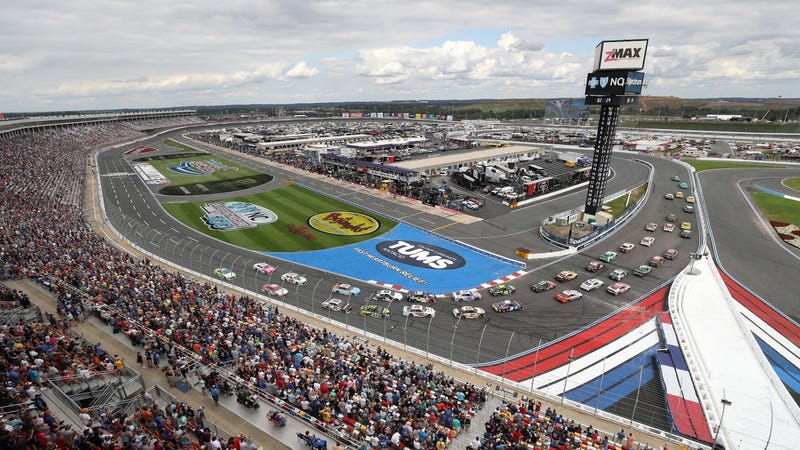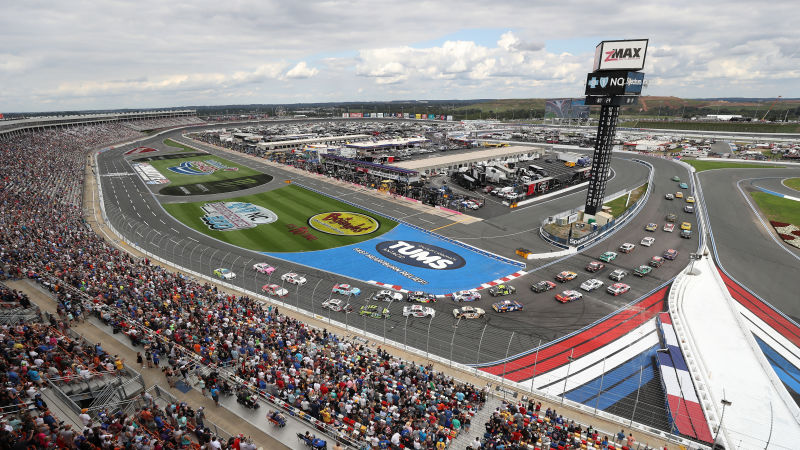
NASCAR’s made a lot of changes to its top levels in the past couple of years, like overhauling how its races and championships work. There’s a lot that still needs to change. But the impacts of competition changes NASCAR has made have been arguable at best, and largely targeting the wrong thing—until the roval, that is.
“Roval” is “road course” and “oval” mashed together in extreme shorthand that surprisingly rolls off the tongue. It’s when a series uses parts of an oval track and a connected road course for a race, like in the 24 Hours of Daytona.
A roval, as opposed to a traditional road course, came to be in NASCAR’s top-level Monster Energy NASCAR Cup Series and second-tier Xfinity Series because of logistics, and logistics really did us a favor with this one.
The roval was the best thing that could have happened to NASCAR. This clip of the Cup Series race finish at over the weekend is one of the many examples why. (You won’t regret spending 96 seconds on this. Watch it. There’s more footage here, if you didn’t watch and need more of an idea of how the race went.)
NASCAR announced the roval last summer, after not having a road race in its 10-race championship “playoffs” since they came around in 2004. The 10 races that make up the playoffs are just the last 10 races of the NASCAR season, and complex scheduling and track agreements have hurt the playoffs for years: In a stretch of races where points are reset and the title is decided, the series should visit at least one of each type of track. NASCAR hasn’t done that, since it doesn’t often pick and change its venues each season like, for example, Formula One.
Advertisement
Instead, the playoffs have mostly been dominated by 1.5-mile ovals, just like the rest of the season. There were no road courses until this year, which made for a huge oversight on NASCAR’s part—since there are only a couple of road courses each season in NASCAR’s top levels, they’re a huge weak point for some drivers. A champion should at least be able to get through one without a huge points hit.
But this year, NASCAR finally found a way to make a road race work without a huge schedule change: a roval. NASCAR showed off the track drivers would run at Charlotte Motor Speedway in September of this year, trading a 1.5-mile oval with four turns for a 2.4-mile roval with 17. It was hard not to be excited.
That didn’t change when the race weekend rolled around.
Advertisement
The roval was everything NASCAR needed it to be. It was chaotic during testing and practice, with drivers slamming into tire barriers, walls and each other.
That showed just how hard it was to learn a new track, especially when playoff fates depended on it—the roval was an elimination race for the Cup Series title, meaning four drivers were done at the end of it. One of those drivers, seven-time champion Jimmie Johnson, eliminated himself by wrecking for the win.
The roval was also entertaining to watch, even if the chaos didn’t spill over into the entire race. Most of the race was clean, unlike the wreck-filled practices, but it was a good race. It didn’t need wrecks to keep people engaged. The mix of the road course and oval showed a stark difference in driving ability throughout the field, in a way only NASCAR could: Some drivers, the ones more familiar with road racing, were fantastic on the road course and lost loads of time on the oval. Others closed in on cars ahead of them on the oval and then tanked on the road course. It was the ultimate game of cat and mouse, if the mouse got a speed boost every 30 seconds, especially in battles for the lead.
Advertisement
Then there was the spectator perspective. A roval, in any racing series, is the perfect track. It’s a road course, it’s an oval, and it combines the best features of both: the left and right turns with the ability to see the whole track from the stands. Road courses are incredibly fun to watch, but that’s just it—you can’t actually watch them from the stands. You watch one part of the track, as the cars pass by to do the other 18 turns out of your sightline. You wait two minutes, they pass by again, then the cycle repeats. Attending races is a spectacle, sure, but it’s also nice to be able to watch the races you’re attending.
Unlike road races, ovals let people in the stands see the entire track, depending on how high up you are. That makes a road course and an oval mashed together into the perfect pair.
But the roval wasn’t just great for NASCAR in that the racing was fun to watch. It was great for NASCAR because it showed that NASCAR can dig itself out of the rut it so often seems to be in, if it just takes a few chances.
Advertisement
When NASCAR tossed out its race and championship format for a completely new one a couple of years ago, it seemed like it was going after the wrong thing. A big problem with the top levels of NASCAR in recent years, at least asfarastheracingisconcerned, has been the rut it’s created with a lack of diversity in its predominantly 1.5-mile oval tracks and its cars’ heavy dependence on aero. A stab at changing the formats felt like a stab in the dark.
Adding the roval to the series’ schedule, instead, felt like a step out of that rut. It was also a welcome change in pace for a series and a sport that, at its good ol’ boy core, hasn’tchangedmuch in decades.
The racing in NASCAR’s Cup Series is fun to watch right now, and perhaps more people will—if it keeps making headlines, and storylines, like the roval did this weekend.













